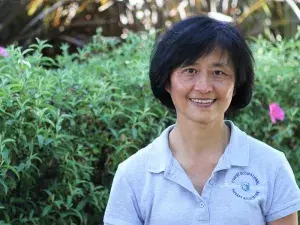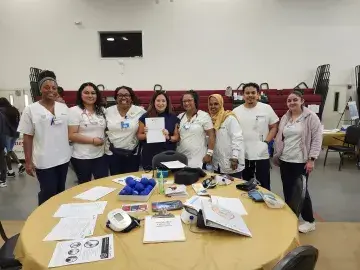Application Fees
Application fees are payable to the Centralized Application Service for Occupational Therapy (OTCAS). Samuel Merritt University does not charge an additional admission fee.
Application Fee = $159
Non-Refundable Deposits and Fees = $350
Students offered admission pay a non-refundable tuition deposit of $350 to secure their seat in the class. Application fees and tuition deposits are non-refundable, whether or not the student withdraws in the first week of the term.
MOT Program, Fall 2025 Start
Current Cost2 | MOT Program Year 1, 32.5 units | MOT Program, Year 2, 33 Units | MOT Program, Level IIb Fieldwork, Fall 2027, 6 units | Total Cost of Program (2.25 years, 88 weeks, 71.5 units) |
Tuition1 | $52, 617.18 | $53,426.671 | $9713.941 | $115,7581 |
Books and Supplies | $2500.00 | $2500.00 | $500.00 | $5500.00 |
Transportation | $500.00 | $2000.00 | $2000.00 | $4500.00 |
Loan Fees3 | $2,895.00 | $2,895.00 | $965.00 | $6755.003 |
Distance Education Fees | $0.00 | $0.00 | $0.00 | $0.00 |
Total Cost of Attendance4 | $58, 512.18 | $60,821.67 | $13,178.94 | $132,512.79 |
1The total tuition estimate does not reflect potential future tuition rate increases.
2Starting August 1st, 2025, SMU will no longer require health insurance to attend SMU. Students are encouraged to secure their own medical insurance, and resources will be provided through Student Services
3Loan fees vary based on loan amount and loan type. Please see the SMU Loan Calculator within our Financial Aid/Scholarships Website
4According to FASFA (Free Application for Federal Student Aid), cost of attendance is defined as total amount of attending the program, which includes tuition and fees, books, supplies, transportation, loan fees as well as fees associated with distance education.
MOT Program, Fall 2024 Start
Current Cost2 | MOT Program Year 1, 37 units | MOT Program, Year 2, 31.5 Units | MOT Program, Level IIb Fieldwork, Fall 2027, 6 units | Total Cost of Program (2.33 years, 99 weeks, 74.5 units) |
Tuition1 | $60,125.00 | $50,998.20 | $9713.941 | $120,837.141 |
Books and Supplies | $2500.00 | $2500.00 | $500.00 | $5500.00 |
Transportation | $500.00 | $2000.00 | $2000.00 | $4500.00 |
Loan Fees3 | $2,895.00 | $2,895.00 | $965.00 | $6755.003 |
Distance Education Fees | $0.00 | $0.00 | $0.00 | $0.00 |
Total Cost of Attendance4 | $66,020 | $58,393.20 | $13,178.94 | $137,592.14 |
1The total tuition estimate does not reflect potential future tuition rate increases.
2Starting August 1st, 2025, SMU will no longer require health insurance to attend SMU. Students are encouraged to secure their own medical insurance, and resources will be provided through Student Services
3Loan fees vary based on loan amount and loan type. Please see the SMU Loan Calculator within our Financial Aid/Scholarships Website
4According to FASFA (Free Application for Federal Student Aid), cost of attendance is defined as total amount of attending the program, which includes tuition and fees, books, supplies, transportation, loan fees as well as fees associated with distance education.
MOT Program, Fall 2023 Start
Current Cost2 | MOT Program Year 1, 38 units | MOT Program, Year 2, 31.5 Units | MOT Program, Level IIb Fieldwork, Fall 2027, 6 units | Total Cost of Program (2.33 years, 99 weeks, 75.5 units) |
Tuition1 | $61, 750 | $51, 187.50 | $9713.94 | $122, 651.441 |
Books and Supplies | $2500.00 | $2500.00 | $500.00 | $5500.00 |
Transportation | $500.00 | $2000.00 | $2000.00 | $4500.00 |
Loan Fees3 | $2,895.00 | $2,895.00 | $965.00 | $6755.003 |
Distance Education Fees | $0.00 | $0.00 | $0.00 | $0.00 |
Total Cost of Attendance4 | $67,645.00 | $58,582.50 | $13,178.94 | $139,406.44 |
1The total tuition estimate does not reflect potential future tuition rate increases.
2Starting August 1st, 2025, SMU will no longer require health insurance to attend SMU. Students are encouraged to secure their own medical insurance, and resources will be provided through Student Services
3Loan fees vary based on loan amount and loan type. Please see the SMU Loan Calculator within our Financial Aid/Scholarships Website
4According to FASFA (Free Application for Federal Student Aid), cost of attendance is defined as total amount of attending the program, which includes tuition and fees, books, supplies, transportation, loan fees as well as fees associated with distance education.
4According to FASFA (Free Application for Federal Student Aid), cost of attendance is defined as total amount of attending the program, which includes tuition and fees, books, supplies, transportation, loan fees as well as fees associated with distance education.













